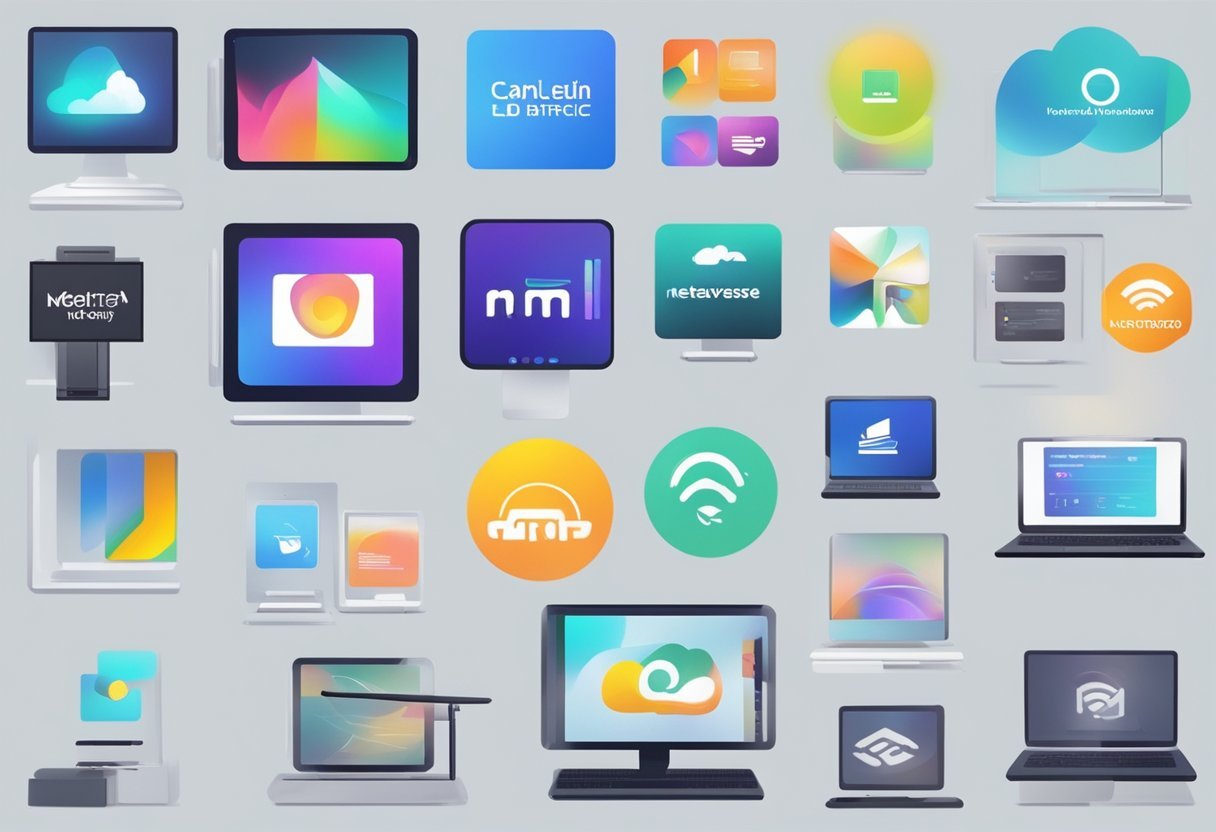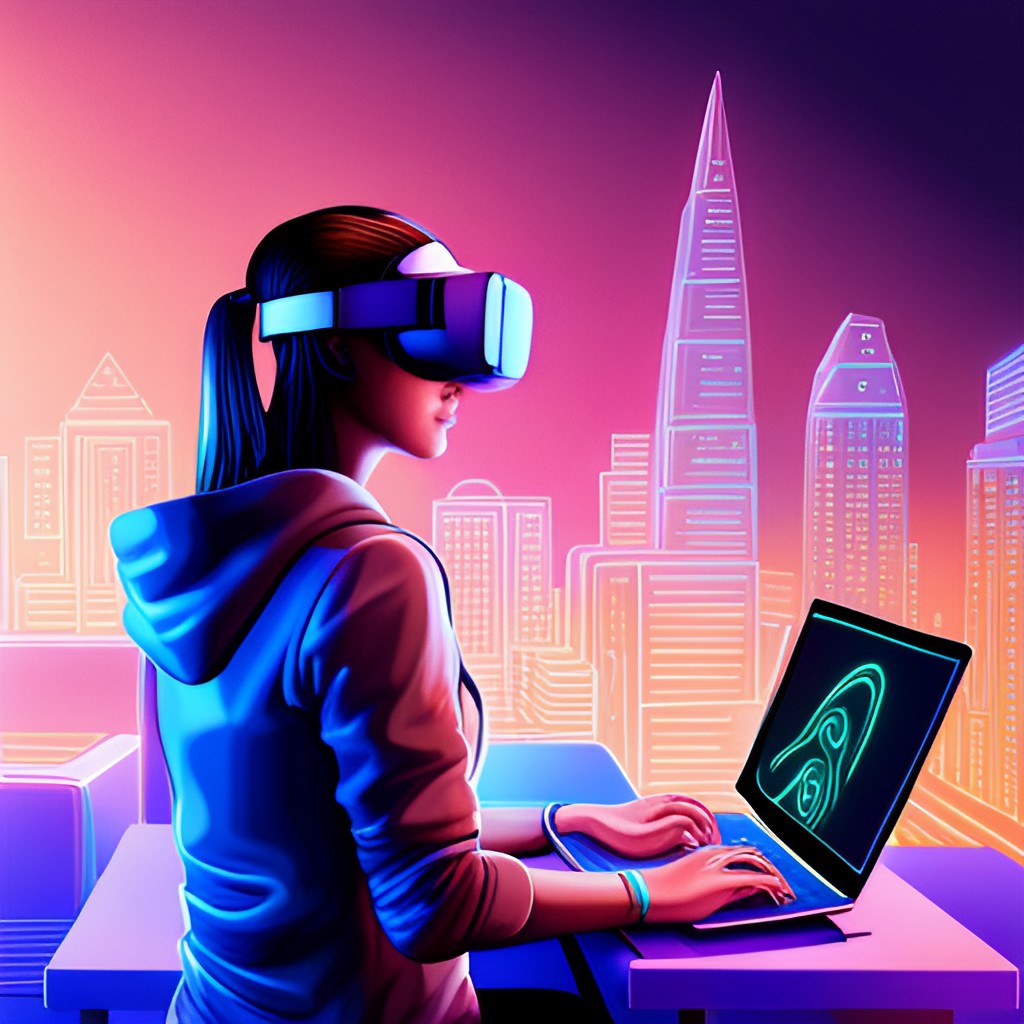Metaverse technology is a rapidly growing field that is revolutionizing the way we interact with the digital world. It refers to a combination of virtual reality, augmented reality, and the internet, creating a shared space where people can interact with each other and digital objects in real-time. The term “metaverse” was first coined in science fiction, but it is quickly becoming a reality.
Virtual reality (VR) and augmented reality (AR) are two key technologies that are driving the development of the metaverse. VR allows users to enter a fully immersive digital environment, while AR overlays digital information onto the real world. The internet is also an important component of the metaverse, providing the backbone for communication and data exchange. Together, these technologies are creating a new kind of digital space that has the potential to transform the way we work, play, and interact with each other.
Evolution and Impact of the Metaverse
Historical Context of the Metaverse
The concept of the Metaverse is not new. It was first introduced in Neal Stephenson’s 1992 novel, Snow Crash, which presented a virtual world where people could interact with each other using avatars. Since then, the idea of a fully immersive virtual world has been explored in science fiction and has now become a reality. The Metaverse is a virtual environment where users can interact with each other and with virtual objects in a persistent, decentralized world.
Influence on Modern Technology
The Metaverse is built on emerging technologies such as virtual reality (VR), augmented reality (AR), spatial computing, the internet of things (IoT), 5G, cloud computing, artificial intelligence (AI), and generative AI. It has already influenced the development of these technologies and will continue to do so in the future. The Metaverse is also driving the development of virtual real estate, which is becoming an important part of the digital economy.
Impact on Society and Economy
The Metaverse has the potential to transform society and the economy. It can be used for e-commerce, social media, marketing, and much more. The Metaverse economy is expected to be worth billions of dollars, with virtual real estate becoming more valuable. The Metaverse can also be used for education, healthcare, and entertainment. It can be a platform for people to connect and collaborate, regardless of their location.
Role of Key Players
Several companies are investing in the Metaverse, including Facebook (now Meta), Microsoft, Google, Nvidia, Apple, Roblox, Fortnite, Unity, Epic Games, and Snap. These companies are developing technologies and platforms that will enable users to access the Metaverse. Mark Zuckerberg, the CEO of Meta, has stated that the Metaverse is the next generation of the internet and will be a key part of the company’s future.
Future Implications
The Metaverse has the potential to change the way we live, work, and interact with each other. It is a persistent, decentralized world that can be accessed from anywhere, at any time. The Metaverse is expected to become more interoperable, allowing users to move between different virtual worlds seamlessly. It will also become more immersive, with the development of haptic feedback and other technologies. The Metaverse is still in its early stages, but it has the potential to revolutionize the way we experience the digital world.

What is Metaverse Technology?
Metaverse technology is a term that refers to the virtual universe of interconnected digital worlds, where users can interact with each other and the environment in various ways. It is a combination of virtual reality (VR), augmented reality (AR), blockchain technology, and other elements that enable the creation of immersive, interactive, and decentralized digital environments.
Technological Foundations
Metaverse technology is built on several technological foundations, including VR and AR, blockchain, and hologram technology. VR and AR enable users to experience immersive and interactive digital environments, while blockchain technology provides a decentralized and secure infrastructure for transactions and digital asset ownership. Hologram technology allows for the creation of three-dimensional images that can be projected into the real world, enhancing the user’s experience.
Key Components and Features
Metaverse technology has several key components and features, including devices such as phones, computers, and virtual reality headsets. These devices enable users to access the metaverse and interact with the digital environment. Avatars are also an essential component of the metaverse, allowing users to represent themselves in the digital world. Virtual worlds are another critical feature of the metaverse, providing users with a space to interact with each other and the environment. NFTs (non-fungible tokens) are digital assets that can be used to represent ownership of virtual items, such as virtual real estate, art, or other collectibles.
Security and Privacy Concerns
As with any emerging technology, metaverse technology raises concerns about security and privacy. Misinformation and abuse are potential risks, as are concerns about data privacy and ownership. There are also concerns about the potential for virtual crime, such as theft and fraud, and the need for secure and decentralized infrastructure to prevent such activities.
In conclusion, metaverse technology is an emerging field that combines various technologies to create an immersive and interactive digital environment. While it has the potential to revolutionize the way we interact with each other and the environment, it also raises concerns about security, privacy, and ownership.
Navigating the Metaverse
The metaverse is an immersive and interactive virtual world that is accessible through the internet. It is a collective virtual shared space that is created by the convergence of physical and digital reality. In this section, we will discuss the various aspects of navigating the metaverse.
Access and Interaction
Accessing the metaverse requires a stable internet connection and a compatible device such as a VR headset or a computer. Once inside the metaverse, users can interact with other users and the virtual environment using avatars. The experience is highly immersive and can be customized to suit individual preferences.
Commercial Opportunities
The metaverse offers significant commercial opportunities for companies and brands. It offers a new platform for advertising, shopping, and real estate. Investors are already investing heavily in metaverse technology, and companies are exploring ways to leverage the technology to create new revenue streams.
Educational and Healthcare Prospects
The metaverse also offers prospects in the field of education and healthcare. It offers a new platform for remote learning and telemedicine. Virtual classrooms and medical consultations can be conducted in a highly immersive and interactive environment.
Entertainment and Gaming Experiences
The metaverse offers a new platform for entertainment and gaming experiences. Virtual concerts, gaming tournaments, and other events can be conducted in a highly immersive environment. Minecraft, a popular game, has already integrated with the metaverse, allowing players to explore a virtual world.
Challenges and Limitations
The metaverse is still in its early stages, and there are several challenges and limitations that need to be addressed. Interoperability and infrastructure are major challenges that need to be overcome to create a seamless experience for users. The term ‘metaverse’ is also a buzzword that is often used loosely, making it difficult to define the technology accurately.
In conclusion, navigating the metaverse requires a stable internet connection and a compatible device. The metaverse offers significant commercial opportunities for companies and brands, as well as prospects in the field of education and healthcare. The metaverse also offers a new platform for entertainment and gaming experiences. However, there are several challenges and limitations that need to be addressed to create a truly immersive and interactive experience for users.

The Role of the Metaverse in Work and Social Interactions
The metaverse is an emerging technology that has the potential to revolutionize the way people work and interact with each other. It is a virtual world that allows users to interact with each other in a digital environment. The metaverse has several use cases, including virtual workspaces and meetings, social interactions and community building, brand presence and marketing, and potential misuses and abuses.
Virtual Workspaces and Meetings
The metaverse has the potential to change the way people work. It allows for virtual workspaces and meetings, which can save time and money. Virtual workspaces can be customized to meet the needs of individual teams, and virtual meetings can be scheduled at any time, making it easier for teams to collaborate across different time zones.
Social Interactions and Community Building
The metaverse also has the potential to change the way people interact with each other. It allows for social interactions and community building in a virtual environment. Users can create avatars to represent themselves and interact with other users in a variety of ways, including chat, voice, and video.
Brand Presence and Marketing
The metaverse also has the potential to change the way brands interact with their customers. Brands can create a presence in the metaverse and interact with users in a variety of ways, including advertising, product demonstrations, and customer support. For example, Coca-Cola has created a virtual vending machine in Decentraland, a metaverse platform, where users can purchase virtual cans of Coca-Cola using cryptocurrency.
Potential Misuses and Abuses
While the metaverse has many potential benefits, it also has the potential for misuse and abuse. One concern is the spread of misinformation and fake news in the metaverse. Another concern is the potential for abuse, such as cyberbullying and harassment.
The Future of Work and Social Interactions
The metaverse is still in its early stages, but it has the potential to change the way people work and interact with each other. As technology continues to evolve, the metaverse will likely become more advanced and sophisticated. Smartphones and other technologies will also play a role in the development of the metaverse, making it more accessible to a wider audience. As the metaverse continues to evolve, it will be important to consider issues such as governance and regulation to ensure that it is used in a responsible and ethical manner.
Frequently Asked Questions
What are some examples of metaverse platforms for business?
There are several metaverse platforms for business, including Decentraland, Somnium Space, and The Sandbox. These platforms allow businesses to create virtual environments to showcase their products and services, hold meetings and events, and engage with customers.
What are some applications of metaverse technology?
Metaverse technology has a wide range of applications, including virtual worlds, social media, avatars, and immersive experiences such as virtual concerts. It can also be used for investment and real estate, education and healthcare, gaming and entertainment, and even shopping.
Who currently owns metaverse technology?
There is no single owner of metaverse technology. Instead, it is being developed by a variety of companies, investors, and individuals. Some of the major players in the space include Facebook, Google, and Microsoft.
What are the requirements for metaverse technology?
Metaverse technology requires a variety of infrastructure, including hardware such as smartphones and virtual reality headsets, as well as software and internet access. It also requires interoperability between different platforms and technologies.
How do you access the metaverse?
Accessing the metaverse depends on the platform being used. Some platforms, such as Decentraland or The Sandbox, require a specific software or browser extension. Others, such as social media or gaming platforms, may be accessed through a mobile app or website.
What is the metaverse and how does it work?
The metaverse is a virtual environment that allows users to interact with each other and with digital content in a highly immersive and interactive way. It works by using a combination of technologies such as virtual reality, augmented reality, and blockchain to create a seamless and interconnected experience.
What is a metaverse example?
One example of a metaverse is Second Life, a virtual world that allows users to create avatars and interact with each other in a variety of settings. Another example is Minecraft, a popular game that allows users to build and explore virtual worlds.
What is the point of metaverse?
The point of the metaverse is to create a highly immersive and interactive environment that allows users to engage with each other and with digital content in new and innovative ways. It has the potential to revolutionize industries such as gaming, entertainment, and education.
Is the metaverse going to happen?
The metaverse is already happening, with a variety of platforms and technologies being developed and used around the world. However, there are still challenges to be overcome, such as interoperability and infrastructure, as well as concerns around security, privacy, abuse, and misinformation.
How to learn metaverse technology?
There are many resources available for learning metaverse technology, including online courses, tutorials, and communities. Some popular platforms for learning include Udemy, Coursera, and YouTube. It is also important to stay up-to-date with the latest developments and trends in the industry.




